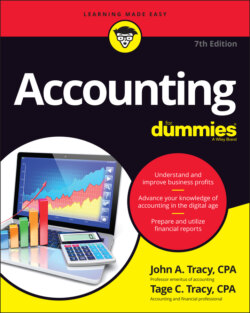Читать книгу Accounting For Dummies - John A. Tracy - Страница 45
Presenting the components of the statement of cash flows
ОглавлениеSuccessful business managers tell you that they have to manage both profit and cash flow; you can’t do one and ignore the other. Business managers have to deal with a two-headed dragon in this respect. Ignoring cash flow can pull the rug out from under a successful profit formula.
Figure 2-3 shows the basic information components of the statement of cash flows for the business example we’ve been using in this chapter. The cash activity of the business during the period is grouped into five sections:
First, almost all statements of cash flow start where the income statement left off — that is, by presenting the net profit or loss for the period. You’ll notice that the net profit at the bottom of the income statement in Figure 2-1 agrees with the net profit at the top of the statement of cash flows in Figure 2-3 (which it should).
Second, all non-cash expenses such as depreciation and amortization expenses are called out, which get added back to net profit. This should make sense given that the expenses are “non-cash.”
The third figure reconciles net income for the period with the cash flow from the business’s profit-making activities, or operating activities, including increases and decreases in current assets (for example, trade accounts receivables and inventory) and current liabilities (for example, trade accounts payables and accrued liabilities).
The fourth figure summarizes the company’s investing transactions during the period, or more specifically, what long-term assets the company purchased or invested in.
And finally the fifth figure reports the company’s financing transactions, or more specifically, whether the company raised cash from securing a loan or selling stock or whether the company used cash to repay loans or issue a dividend.
The net increase or decrease in cash from the five types of cash activities during the period is added to or subtracted from the beginning cash balance to get the cash balance at the end of the year.
In the example, the business earned a $4.482 million profit (net income) during the year (see Figure 2-1), which included non-cash expenses of $1.739 million (primarily for depreciation expense) that need to be added back to properly reconcile cash changes during the period. The cash result of its operating activities was to increase its cash by $1.372 million, which you see in the first part of the statement of cash flows (see Figure 2-3). The actual cash inflows from revenues and outflows for expenses run on a different timetable from when the sales revenue and expenses are recorded for determining profit. We give a more comprehensive explanation of the differences between cash flows and sales revenue and expenses in Chapter 8.
The next part of the statement of cash flows sums up the long-term investments the business made during the year, such as constructing a new production plant or replacing machinery and equipment. If the business sold any of its long-term assets, it reports the cash inflows from these divestments in this section of the statement of cash flows. The cash flows of other investment activities (if any) are reported in this part of the statement as well. As you can see in Figure 2-3, the business invested $750,000 in new long-term operating assets (trucks, equipment, tools, and computers).
© John Wiley & Sons, Inc.
FIGURE 2-3: Information components of the statement of cash flows.
The final part of the statement sums up the dealings between the business and its sources of capital during the period — borrowing money from lenders and raising capital from its owners. Cash outflows to pay debt are reported in this section, as are cash distributions from profit paid to the owners of the business. The final part of the example statement shows that the result of these transactions was to increase cash by $3.650 million. (By the way, in this example, the business did make a dividend payment to the shareholders from profit. It probably could have been larger, but it wasn’t — which is an important point that we discuss in the later section “Why no (or limited) cash distribution from profit?”)
As you see in Figure 2-3, the net result of the five types of cash activities was a $10.493 million increase during the year. The increase is added to the cash balance at the start of the year to get the cash balance at the end of the year, which is $11.281 million. We should make one point clear: The $10.493 cash increase during the year (in this example) is never referred to as a cash flow bottom line or any such thing.
The term bottom line is reserved for the final line of the income statement, which reports net income — the final amount of profit after all expenses are deducted.
